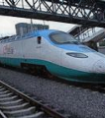The 18-meter-tall Rubber Duck arrived in Beijing on Friday. It was placed on waters in the International Garden Expo Park, where the Yongding River passes throu-九年级英语
题文
| The 18-meter-tall Rubber Duck arrived in Beijing on Friday. It was placed on waters in the International Garden Expo Park, where the Yongding River passes through. The Rubber Duck exhibition was designed by Dutch artist, Florentijn Hofman. It was part of the activities of Beijing Design Week, which ran from September 26 to October 3 in 2013. The Rubber Duck stayed in the park until September 23, then moved to the Summer Palace, a famous Beijing tourist spot, where it was on display until October 26. The duck is made of over 200 pieces of rubber. It was guarded not only by staff, but also by 10 volunteers wearing yellow T-shirts and hats with a rubber duck logo. Sun Yidong, a volunteer who guided visitors to the duck, said the art brought energy to the traditional Chinese park. “Seeing the giant Rubber Duck makes me feel like I’m a kid again.” Sun said. Because of the rain on Friday, there were not too many people coming to see it. The Expo workers said they expected more people to come and visit the duck on weekends. Zhao Yan said she had been following news about the duck since 2007, when the duck began its journey. “I even considered going to Hong Kong to see it. It’s great that the duck is in Beijing,” Zhao said. Before arriving in Beijing, the Rubber Duck traveled to 13 cities in nine countries. “The aim of the Rubber Duck is simply to bring everyone back to their childhood again,” said Zeng Hui, a leader of the Beijing Design Week Organizing Committee Office. “It can be a toy for adults.” 根据材料内容选择最佳答案,并将其标号填涂在答题卡的相应位置。 小题1:The Rubber Duck went to _______ after it left the International Garden Expo Park.
|
答案
小题1:B 小题2:B 小题3:C 小题4:D 小题5:A |
试题分析:这篇文章讲述的是橡皮鸭的有关情况,包括它的设计,在北京展览所经过的途径,同时给出了人们对它的评价和看法。 小题1:细节理解题。根据文中原句The Rubber Duck stayed in the park until September 23, then moved to the Summer Palace(橡皮鸭在这个公园一直待到九月23号,然后就移动到颐和园),故选B。 小题2:细节理解题。根据文中原句The 18-meter-tall Rubber Duck arrived in Beijing on Friday.(十八米高的橡皮鸭在星期五到达北京),故选B。 小题3:细节理解题。根据文中原句Because of the rain on Friday, there were not too many people coming to see it. (因为星期五下雨,所以来看橡皮鸭的人并不很多),所以此题选C(因为天气不好)。 小题4:细节理解题。根据文中原句The Rubber Duck exhibition was designed by Dutch artist, Florentijn Hofman.(橡皮鸭展览是有荷兰艺术家Florentijn Hofman设计的),所以D的描述是错误的。 小题5:主旨大意题。根据文中所提供的信息及最后一段的描述,橡皮鸭能使人想起童年,故选A。 |
据专家权威分析,试题“The 18-meter-tall Rubber Duck arrived in Beijing on Friday...”主要考查你对 新闻报道类阅读 等考点的理解。关于这些考点的“档案”如下:
新闻报道类阅读
考点名称:新闻报道类阅读
- 报刊阅读应逐步成为中学生阅读的一个重要内容。由于新闻报道强调遵循5个W和1个H的原则,学生在阅读时也要抓住这一点去理解。
- 新闻报道类阅读的注意事项:
1. 品味新闻的标题,联系平时所积累的知识,为了解材料大意作铺垫。
2. 了解新闻报道的特殊规律,其内容和多含何人、何地、何事、何时等,阅读时要抓住新闻的这一主要特点去理解判断。
3. 要注意文中以黑体、大写、下划线等方式加以提示的文字,因为这很有可能是材料的核心或至少是一部分内容的概括。
新闻报道类阅读答题技巧:
1.审视标题,抓住中心<?xml:namespace prefix = "o" ns = "urn:schemas-microsoft-com:office:office" />
试题中有的文章有标题,有的没有,拟题人是有所考虑的。标题是文章主题的高度凝聚。
它能给我们启发和想象,想象文章的内容和走向。这样做有利于对文章的理解,能提高做题的效率。2.浏览全文,掌握全貌
如果时间紧,至少要快速通读全文,尤其是首两段。再把标题和文章内容结合起来,这样全文的梗概便一目了然了。
3.细读题目,抓住要点
对整篇短文内容有了一定的了解后,要马上看短文后的问题,带着问题去选择或判断答案。要确定所需查找的信息范围,并注意所查找信息的特点。例如:
如果问题或选项涉及到人名、地名,就应该找首字母大写的单词;如果问题或选项涉及时间、日期、数字,就应该寻找具体的数据。
- 最新内容
- 相关内容
- 网友推荐
- 图文推荐
| [家长教育] 孩子为什么会和父母感情疏离? (2019-07-14) |
| [教师分享] 给远方姐姐的一封信 (2018-11-07) |
| [教师分享] 伸缩门 (2018-11-07) |
| [教师分享] 回家乡 (2018-11-07) |
| [教师分享] 是风味也是人间 (2018-11-07) |
| [教师分享] 一句格言的启示 (2018-11-07) |
| [教师分享] 无规矩不成方圆 (2018-11-07) |
| [教师分享] 第十届全国教育名家论坛有感(二) (2018-11-07) |
| [教师分享] 贪玩的小狗 (2018-11-07) |
| [教师分享] 未命名文章 (2018-11-07) |






